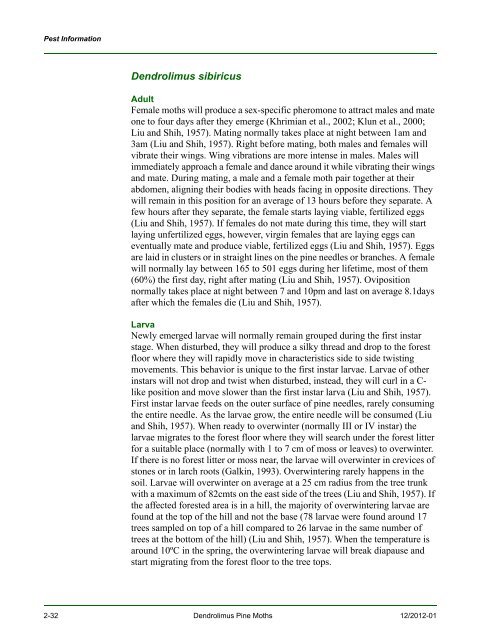New Pest Response Guidelines - aphis - US Department of Agriculture
New Pest Response Guidelines - aphis - US Department of Agriculture
New Pest Response Guidelines - aphis - US Department of Agriculture
You also want an ePaper? Increase the reach of your titles
YUMPU automatically turns print PDFs into web optimized ePapers that Google loves.
<strong>Pest</strong> Information<br />
Dendrolimus sibiricus<br />
Adult<br />
Female moths will produce a sex-specific pheromone to attract males and mate<br />
one to four days after they emerge (Khrimian et al., 2002; Klun et al., 2000;<br />
Liu and Shih, 1957). Mating normally takes place at night between 1am and<br />
3am (Liu and Shih, 1957). Right before mating, both males and females will<br />
vibrate their wings. Wing vibrations are more intense in males. Males will<br />
immediately approach a female and dance around it while vibrating their wings<br />
and mate. During mating, a male and a female moth pair together at their<br />
abdomen, aligning their bodies with heads facing in opposite directions. They<br />
will remain in this position for an average <strong>of</strong> 13 hours before they separate. A<br />
few hours after they separate, the female starts laying viable, fertilized eggs<br />
(Liu and Shih, 1957). If females do not mate during this time, they will start<br />
laying unfertilized eggs, however, virgin females that are laying eggs can<br />
eventually mate and produce viable, fertilized eggs (Liu and Shih, 1957). Eggs<br />
are laid in clusters or in straight lines on the pine needles or branches. A female<br />
will normally lay between 165 to 501 eggs during her lifetime, most <strong>of</strong> them<br />
(60%) the first day, right after mating (Liu and Shih, 1957). Oviposition<br />
normally takes place at night between 7 and 10pm and last on average 8.1days<br />
after which the females die (Liu and Shih, 1957).<br />
Larva<br />
<strong>New</strong>ly emerged larvae will normally remain grouped during the first instar<br />
stage. When disturbed, they will produce a silky thread and drop to the forest<br />
floor where they will rapidly move in characteristics side to side twisting<br />
movements. This behavior is unique to the first instar larvae. Larvae <strong>of</strong> other<br />
instars will not drop and twist when disturbed, instead, they will curl in a Clike<br />
position and move slower than the first instar larva (Liu and Shih, 1957).<br />
First instar larvae feeds on the outer surface <strong>of</strong> pine needles, rarely consuming<br />
the entire needle. As the larvae grow, the entire needle will be consumed (Liu<br />
and Shih, 1957). When ready to overwinter (normally III or IV instar) the<br />
larvae migrates to the forest floor where they will search under the forest litter<br />
for a suitable place (normally with 1 to 7 cm <strong>of</strong> moss or leaves) to overwinter.<br />
If there is no forest litter or moss near, the larvae will overwinter in crevices <strong>of</strong><br />
stones or in larch roots (Galkin, 1993). Overwintering rarely happens in the<br />
soil. Larvae will overwinter on average at a 25 cm radius from the tree trunk<br />
with a maximum <strong>of</strong> 82cmts on the east side <strong>of</strong> the trees (Liu and Shih, 1957). If<br />
the affected forested area is in a hill, the majority <strong>of</strong> overwintering larvae are<br />
found at the top <strong>of</strong> the hill and not the base (78 larvae were found around 17<br />
trees sampled on top <strong>of</strong> a hill compared to 26 larvae in the same number <strong>of</strong><br />
trees at the bottom <strong>of</strong> the hill) (Liu and Shih, 1957). When the temperature is<br />
around 10ºC in the spring, the overwintering larvae will break diapause and<br />
start migrating from the forest floor to the tree tops.<br />
2-32 Dendrolimus Pine Moths 12/2012-01

















